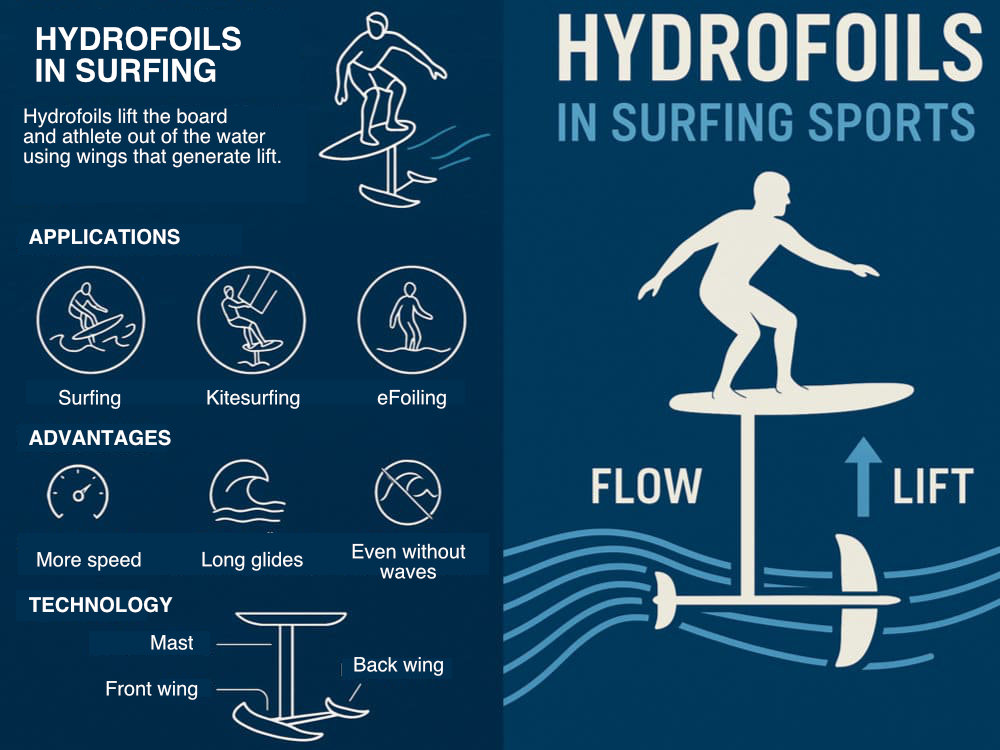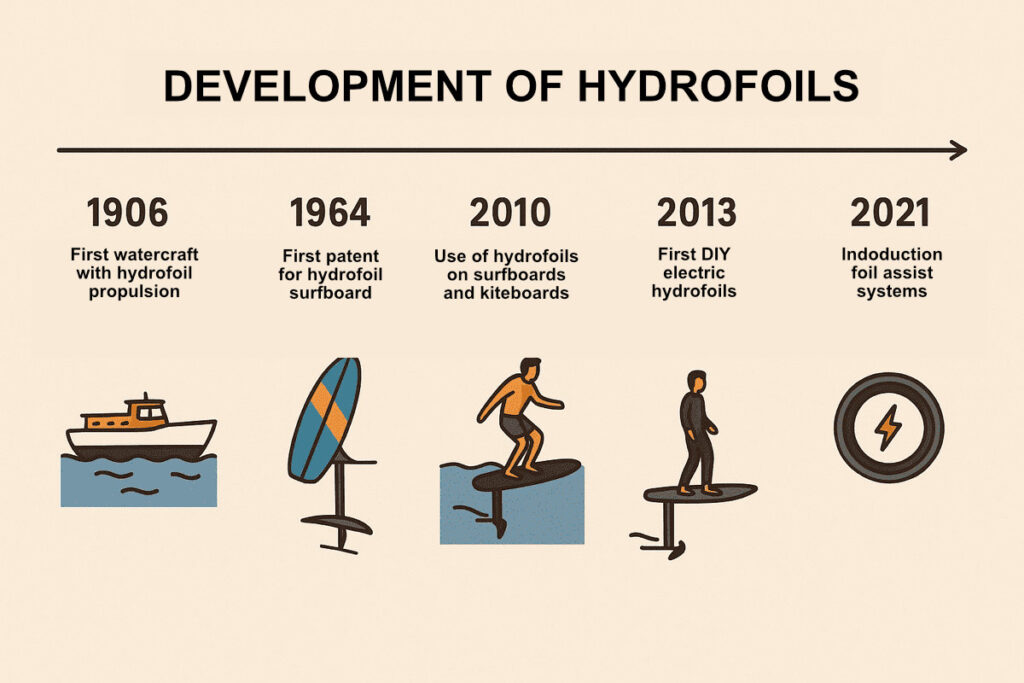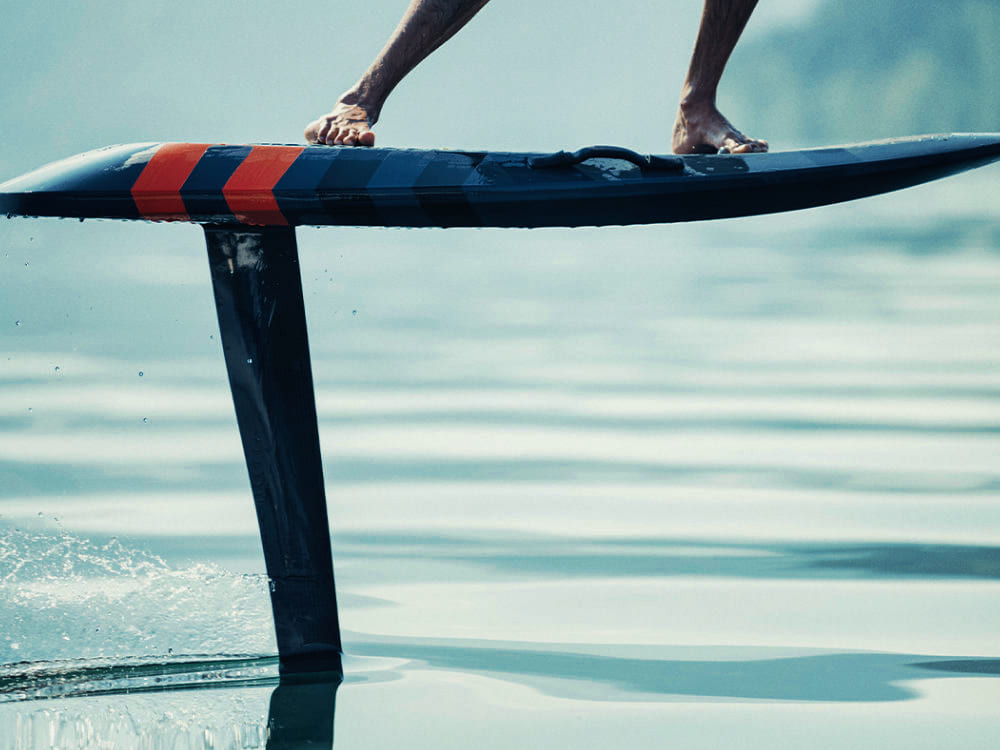The hydrofoil, also known as the “foil,” has revolutionized the world of water sports in recent years. From surfing to eFoiling.
Foil technology
Hydrofoil technology has established itself in various disciplines and is opening up new possibilities on the water. In this article, we take a comprehensive look at the technology, history, and various applications of hydrofoils in surfing. We place a special focus on the innovative eFoil, which is enjoying rapidly growing popularity.
The technology behind the hydrofoil A hydrofoil is an underwater wing system that is mounted under a surfboard, kiteboard, windsurf board, or other platform. It usually consists of a vertical mast structure and horizontal wings (front and rear wings).

As soon as the board moves through the water at sufficient speed, the foil generates buoyancy. This lifts the board above the water's surface, greatly reducing water resistance and enabling almost silent, floating gliding.
The biggest advantage of hydrofoil technology is the reduction in friction. While conventional boards plow through the water's surface, foil boards glide on the lift of the wing, offering higher speeds, better maneuverability, and a completely new riding experience.
How a hydrofoil works underwater:
- Flow: The water flows against the front wing of the foil. The shape of this wing causes the water to flow faster at the top and slower at the bottom.
- Buoyancy: According to Bernoulli's principle, the pressure difference creates buoyancy that lifts the board and rider out of the water.
- Resistance: The foil generates only minimal water resistance compared to a conventional surfboard.
- Front wing: Mainly responsible for the lift effect.
- Rear wing: Stabilizes the system and acts like the elevator of an airplane.
Hydrofoil history
History of the hydrofoil The idea of the hydrofoil is not new. Engineers were already experimenting with hydrofoils at the beginning of the 20th century. Italian inventor Enrico Forlanini developed one of the first functioning hydrofoils in 1906. In the 1950s and 60s, hydrofoils were mainly used for military and commercial purposes.
In water sports, however, it took until the 1990s before foils attracted significant interest. They were first used in sailing, for example in the America's Cup. With miniaturization and improvements in materials, hydrofoils finally found their way into recreational sports—first in windsurfing, then in kitesurfing, and finally in surfing and stand-up paddleboarding (SUP).

Hydrofoil in surfing
- Kitefoiling: The hydrofoil has opened up completely new possibilities in kitesurfing. In light winds, where conventional kiteboards are almost impossible to ride, a foilboard can be operated with little pull. Kitefoilers reach high speeds and can glide almost effortlessly over long distances on the water.
- Surf foiling: In surf foiling, the foil is mounted under a surfboard. The rider paddles as in conventional surfing, but as soon as they catch a wave, the board lifts out of the water. The foil allows you to glide for a very long time on a small wave, as the board suffers almost no friction loss. However, this technique requires a high degree of balance and skill.
- SUP foiling: Foiling has also found its way into stand-up paddling. This is particularly beneficial for experienced paddlers who work with smaller waves or go downwind. The combination of paddle and foil enables a whole new way of gliding.
- Wing foiling: Wing foiling is one of the newest disciplines in foil sports. An inflatable wing (similar to a kite, but without lines) is held in the hands. The rider stands on a foil board and uses the wind to move across the water. This discipline is rapidly growing in popularity as it is relatively easy to learn and works in a wide range of conditions.
eFoil - Electric Hydrofoil
eFoil – The electric revolution. What is an eFoil? eFoils are electric surfboards with an integrated hydrofoil and an emission-free electric motor. The motor is located at the bottom of the mast and propels the board through a propeller or jet.
The eFoil is controlled via a wireless remote control held in the hand. This allows the rider to regulate the speed and move effortlessly across the water – without any wind or waves.
Here is a video from the E-SURFER YouTube channel:
Advantages of eFoiling
- Independence from weather conditions: Unlike kite, surf, or wing foiling, no special weather conditions are required.
- Easy control: Electronic controls make riding easier for beginners.
- Silent gliding: The electric motor is virtually silent, offering an intense experience of nature.
- Training and fitness: eFoiling requires balance, coordination, and muscle strength, making it a valuable form of exercise.
The battery life of modern eFoils is around 60 to 90 minutes. Depending on the model, charging time is between 1.5 and 3 hours. Speeds of up to 50 km/h are possible. The boards are usually made of carbon fiber or other lightweight materials. The price for a high-quality eFoil is currently between $12,000 and $22,000.
Possible applications eFoils are not only suitable for leisure and sports, but also for professional use, for example in rescue services or for nature tours in waters that are difficult to access.
The first commercial eFoil was launched in 2018 by the company Lift Foils, followed by Fliteboard in 2019. In 2022, Aerofoils revolutionized the eFoil market with the first jetfoil. Since then, all other manufacturers have also adopted the safe jet propulsion system.
Foil Assist
The hybrid innovation Foil Assist is a new technology that lies between pure foiling and eFoiling. It is a small, supportive electric system that assists the rider during takeoff or in difficult conditions. The electric motor only provides assistance when needed, e.g., when starting in choppy water or when approaching small waves.
This technology is particularly interesting for surfers who want to practice foiling in difficult conditions but do not want to use a full-fledged eFoil. Foil Assist can also be valuable in competition training.
The Australian company Foil Drive is considered the pioneer of the Foil Assist system.
Environmental aspects
Safety and environmental aspects: Hydrofoiling is considered a relatively safe sport as long as certain basic rules are observed:
- Keep your distance from other water sports enthusiasts
- Wear protective equipment such as a helmet and impact vest
- Handle the foil safely (sharp edges, hard material)
Safe handling of the electronics is particularly important with eFoils. The batteries must be charged and maintained correctly to avoid defects.
In terms of environmental impact, eFoils are virtually emission-free and silent when in operation. However, their ecological footprint depends heavily on the manufacture and disposal of the batteries.
The future of foiling
Foil technology will continue to evolve in the coming years. The following developments are expected:
- More efficient motors and lighter batteries for eFoils
- Intelligent assistance systems (automatic stabilization, app control)
- Better materials and modularity in foil systems
- Integration into new sports such as wake foiling or foil fishing
In addition, accessibility will increase. Falling prices and better training opportunities will open up foiling to a wider target group.
Conclusion
Hydrofoils have profoundly changed surfing. What once began as an experimental niche technology has now found its way into almost all water sports.
The eFoil in particular makes hovering above the water accessible to a wide audience and opens up completely new dimensions of water sports. With its combination of innovative technology, environmental friendliness, and unique riding experience, foiling represents the future of modern water recreation.


 28 min read
28 min read